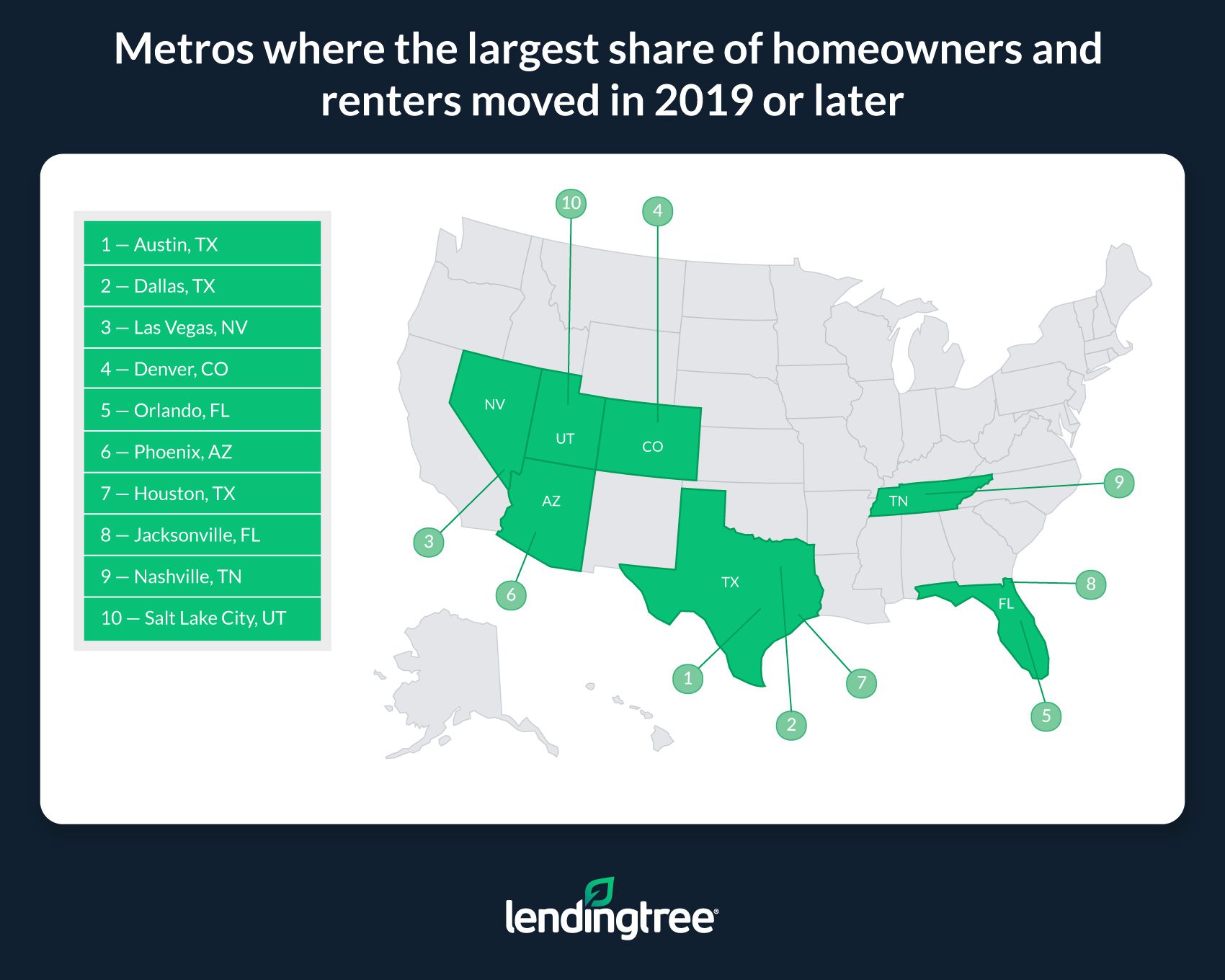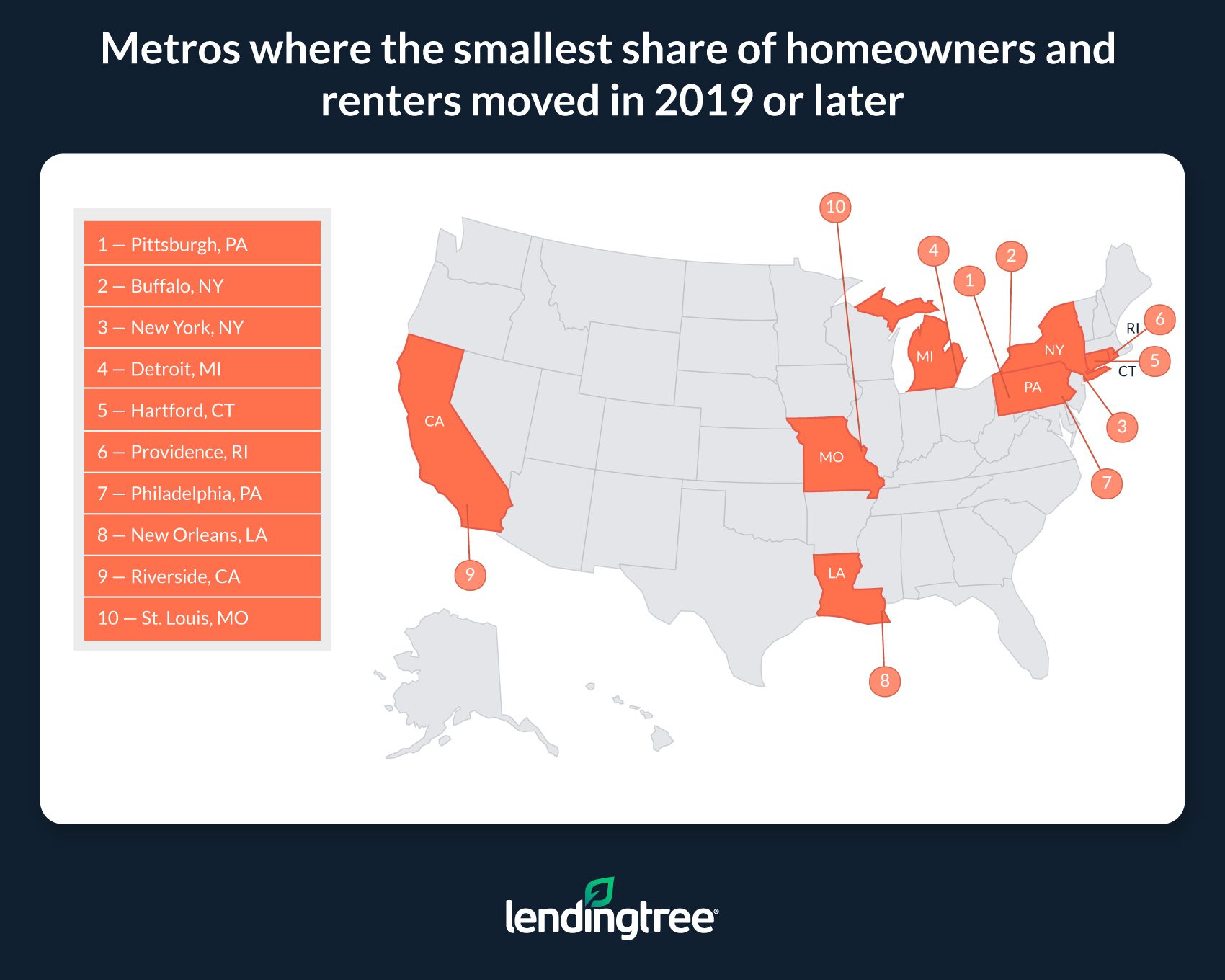On the Move: Nearly 3 in 10 Homeowners and Renters Across the Nation’s Largest Metros Moved in 2019 or Later
Moving can be a challenge, regardless of whether you own or rent a home. This is especially true in today’s economy, where hot inflation and high housing costs can make a change extremely expensive.
While some live in the same home for decades, not everyone can stay in one house that long. Depending on factors like location, some may move more often than others.
LendingTree analyzed U.S. Census Bureau data to determine the largest and smallest share of homeowners and renters — individually and combined — in the nation’s 50 largest metropolitan areas who moved into their current home in 2019 or later.
We found that the share of recent movers can vary significantly by place, and that renters are more than three times as likely to have recently moved than homeowners.
Key findings
- The Austin, Texas, Dallas and Las Vegas metros have the largest share of recent movers. In these metros, an average of 36.18% of homeowners and renters reported moving into their current homes in 2019 or later. Conversely, Pittsburgh, Buffalo, N.Y. and New York City have the smallest share of homeowners and renters who recently moved. In these metros, an average of 21.75% moved into their current homes in 2019 or later. Across the 50 largest metros, an average of 28.97% of homeowners and renters moved into their current place in 2019 or later.
- Renters are more than three times as likely to have recently moved than homeowners. On average, 50.96% of renters across the nation’s 50 largest metros moved into their current homes in 2019 or later, versus an average of 16.76% of homeowners.
- Looking solely at homeowners, the Las Vegas, Phoenix and Tampa, Fla., metros have the largest share that moved in 2019 or later. An average of 22.14% of homeowners in these metros moved into their current houses in 2019 or later. That’s nearly double the 12.22% average among the three metros with the smallest share of recent homeowners who moved — San Jose, Calif., Pittsburgh and Los Angeles.
- The largest share of renters in the 50 largest metros who recently moved live in Austin, Salt Lake City and Denver. In these three metros, an average of 62.39% of renters moved into their current homes in 2019 or later — 11.43 percentage points higher than the 50-metro average. The metros with the smallest share of renters who recently moved are New York, Los Angeles and Riverside, Calif. An average of only 35.75% of renters in these metros moved into their current homes in 2019 or later.
- Metros where a larger share of homeowners have recently moved tend to experience more significant home price appreciation. More movement among homebuyers can reduce the supply of homes for sale in a given area and cause prices to increase. But while there is a strong correlation between the share of homeowners who recently moved and home price appreciation, there’s a much weaker correlation between the share of renters who recently moved and rent appreciation. This shows how buying and renting markets don’t always behave the same way — even if they are related.
Metros where the largest share of homeowners and renters moved in 2019 or later
1. Austin, Texas
- Share of homeowners and renters who moved into their current home in 2019 or later: 38.82%
- Share of homeowners who moved into their current home in 2019 or later: 20.72%
- Share of renters who moved into their current home in 2019 or later: 64.67%
- Three-year median home value appreciation: 24.72%
- Three-year median gross rent appreciation: 7.54%
2. Dallas
- Share of homeowners and renters who moved into their current home in 2019 or later: 34.91%
- Share of homeowners who moved into their current home in 2019 or later: 18.77%
- Share of renters who moved into their current home in 2019 or later: 58.95%
- Three-year median home value appreciation: 16.15%
- Three-year median gross rent appreciation: 8.49%
3. Las Vegas
- Share of homeowners and renters who moved into their current home in 2019 or later: 34.81%
- Share of homeowners who moved into their current home in 2019 or later: 22.64%
- Share of renters who moved into their current home in 2019 or later: 50.73%
- Three-year median home value appreciation: 16.83%
- Three-year median gross rent appreciation: 11.63%

Metros where the smallest share of homeowners and renters moved in 2019 or later
1. Pittsburgh
- Share of homeowners and renters who moved into their current home in 2019 or later: 21.56%
- Share of homeowners who moved into their current home in 2019 or later: 12.16%
- Share of renters who moved into their current home in 2019 or later: 45.07%
- Three-year median home value appreciation: 14.53%
- Three-year median gross rent appreciation: 5.67%
2. Buffalo, N.Y.
- Share of homeowners and renters who moved into their current home in 2019 or later: 21.75%
- Share of homeowners who moved into their current home in 2019 or later: 12.76%
- Share of renters who moved into their current home in 2019 or later: 40.60%
- Three-year median home value appreciation: 19.40%
- Three-year median gross rent appreciation: 7.25%
3. New York
- Share of homeowners and renters who moved into their current home in 2019 or later: 21.93%
- Share of homeowners who moved into their current home in 2019 or later: 12.89%
- Share of renters who moved into their current home in 2019 or later: 31.95%
- Three-year median home value appreciation: 10.52%
- Three-year median gross rent appreciation: 7.96%

Why renters tend to move more often than homeowners
As our study shows, a larger share of recent movers are renters rather than homeowners.
At the same time, while short-term costs may disincentivize homeowners from moving, long-term savings can compel them to keep their current digs. After all, homeowners who live in one place long enough to pay off their mortgages (or who otherwise end up without one) typically spend less on housing costs than renters.
Outside of financial considerations, renters can also be pushed into moving by a landlord who wants to change the lease terms or otherwise decides they want a new tenant. While some regulations protect renters and make it harder for landlords to force them out of their homes, these protections aren’t always robust. Because of this, renters can more frequently find themselves in situations where they’re forced to move, even if they like their current home or are strapped for cash. Similar risks also exist for homeowners — especially those who fall behind on their mortgage payments — but foreclosures are less common than evictions.
This isn’t to say that moving is necessarily cheap and easy for renters, or that homeowners never have financially sound reasons to leave their current houses. On the contrary, moving can be expensive regardless of one’s homeowner status, just as it can be rewarding for someone to sell their current house and head someplace new. Similarly, renters and owners may find themselves forced out of their current homes, even if they’d prefer to keep them. Nonetheless, the data is clear that renters are more likely to move than their homeowning peers.
3 tips for movers
Whether you’re a homeowner or renter, moving can be a hassle. Here are three tips that can help make it a bit more manageable.
- Shop around for everything from lenders to movers. Whether you’re talking about moving companies, landlords or mortgage lenders, different businesses can offer different prices and rates to the same people. Owing to this, shopping around and comparing different offers for everything ranging from a new mortgage to a van to haul your furniture could help you save money during the moving process.
- Try to schedule your move during a less busy time of the year. Generally, warmer months bring with them higher housing prices — as such, waiting to move during the fall or winter when prices typically fall could help you save money. That said, while moving during a colder month might be more cost-effective in many ways, it isn’t without drawbacks. For example, home sellers may find it takes longer to find a buyer in the winter than summer. Similarly, transporting your stuff from one place to another during a blizzard will probably be more difficult than moving on a sunny day.
- Understand what you’re getting yourself into. Just because the grass in a new area might look greener at first glance doesn’t that mean it is. Before packing their bags, would-be movers should do their best to understand what to expect from their new living arrangements. This can include researching commute times and the job market in a new town or city, as well as learning about what maintenance is required to keep a new house in good shape. If you’re overeager and move somewhere new without proper consideration, you could easily be overwhelmed and unhappy.
Methodology
The data in this study comes from the U.S. Census Bureau 2021 American Community Survey with one-year estimates (the latest survey available at the time of publication.)
More specifically, our study looks at the share of householders — defined by the Census Bureau as “the person, or one of the people, in whose name the home is owned, being bought or rented” — who moved into their current home in 2019 or later.
